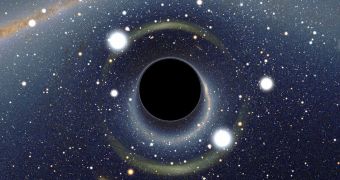For all their “popularity“ with scientists, black holes are still pretty much mysterious in every aspect, including when it comes to their basic properties. For instance, it's still unclear if they spin or not, but that could soon change. A team of scientists is already studying the issue via a new method.
The physics of black holes is still a matter of intense debate, primarily because most studies dealing with the issue are either theoretical, or they deal with the results of computer simulations.
But a team of investigators believes it may have discovered a way of telling if black holes actually spin or not. They say that this trait could be teased out by analyzing the way in which light is distorted as it moves past sch a dark behemoth.
Due to their tremendous gravitational pull, black holes not only draw in matter and light from their surroundings, but they also distort the very fabric of spacetime. But the way in which this fabric is distorted is influenced by many factors.
For example, there is a difference between the gravitational warp caused by a static object and a rotating one. The latter produces an effect called frame-dragging, which was first hypothesized by Albert Einstein in his theory on general relativity.
Its existence was inferred from the theory by Austrian physicists Josef Lense and Hans Thirring back in 1918, and so the phenomenon is also called the Lense–Thirring effect. Detecting it is however a tremendously complex task even around Earth.
However, it's not impossible. The NASA Gravity Probe B (GP-B) mission managed to detect the effect around our planet. Given that Earth deforms spacetime due to gravity and that it also spins, then objects in its orbit should theoretically be slightly drawn into the direction in which it rotates.
The same could be observed by analyzing light bent by black holes. The effect these structures have on light should theoretically differ if they spin, or if they are standing still.
“Light acquires kind of a spiral motion that carries information about the distorted space-time around a black hole. You can imagine that the light that approaches us from the black hole is not going in a straight line, but in spirals,” says scientist Bo Thidé.
He holds an appointment as a space physicist at the Swedish Institute of Space Physics in Uppsala. The expert, also the coauthor of the new investigation, says that this type of light could be easily analyzed, if astronomers have access to a very large telescope.
“This possibility of direct detection of swirling space and time around black holes is one that we think is quite exciting,” Thidé concludes, quoted by Space.
Details of the new study appear in the January 13 online issue of the esteemed journal Nature Physics.

 14 DAY TRIAL //
14 DAY TRIAL //